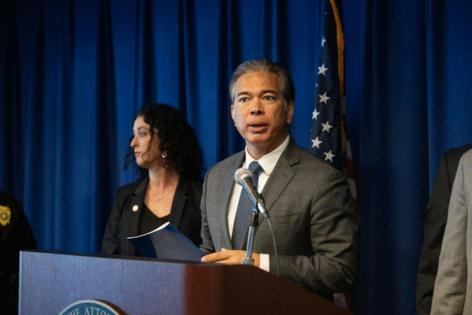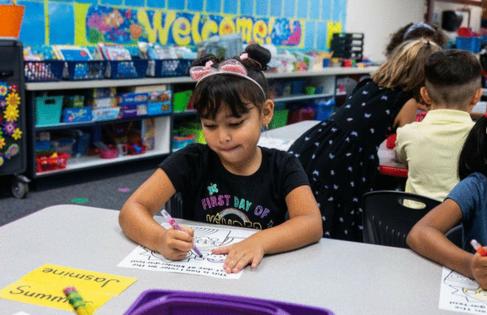Students head back to class as federal funding uncertainties weigh on US schools
Published in News & Features
SACRAMENTO, Calif. — While classes were out for summer, districts were busy preparing for the upcoming school year: Finalizing budgets, hiring staff, building programming and working with the state to secure grants are all a regular part of business when kids are out of class.
But the attitude toward education on a federal level has shifted since President Donald Trump took office in January. Trump has made his stance on the Department of Education clear since his campaign — complete closure.
Since then, the Department of Education has executed a number of actions that California leaders have called “an attack on education.” These include largely unsuccessful attempts to eliminate diversity, equity and inclusion programs in schools and to freeze federal grant money for 33 states as well as material successes for the Trump administration, like the Supreme Court’s greenlighting of 1,400 layoffs at the Department of Education.
Left in the wake are thousands of school districts across the United States that are waiting for answers on what may come next. As students return to class this month and next, the questions that administrators had in the early months of this year remain more or less unanswered.
“We’re still, as with everyone, in a hold pattern,” Elk Grove Unified School District Board President Michael Vargas said. “We’re very mindful of what’s going on at a federal level.”
School districts are watching the feds carefully and relying on the California Department of Education to provide guidance in the case that there is a new effort to remove autonomy or funding from public schools.
“We’ve had several things come down from the federal government starting last school year,” Natomas Unified School District Superintendent Robyn Castillo said. “Some of them have been vague and the state of California has responded to those and given us guidance.”
Funding uncertainty
Last month, schools across 33 states faced an unprecedented scenario in which the Department of Education withheld nearly $7 billion in education funding appropriated by Congress under the pretense of reviewing several grant programs for compliance with President Donald Trump’s policy priorities, saying that they found that some money had been “grossly misused to subsidize a radical left-wing agenda.”
The Trump administration backed down several weeks later and the nearly $1 billion held from California schools returned to support state programs including adult education, after-school services, teacher training, and services for marginalized students such as children of migrant workers and English language learners.
Vargas said that while Elk Grove Unified wasn’t materially affected by the pause in funding, part of this comes from their relatively unique position as a large, growing school district. With help from reserves and their general fund, the district likely could have made good on the contracts they had already entered with employees and third-parties. The case may not be the same in a smaller, rural district with fewer resources.
DEI policies
Another looming question surrounds the administration’s February mandate (and a related April executive order) that public K-12 schools and colleges shut down race-based policies and programming or face investigations and the possible loss of federal funding. An April ruling by a New Hampshire judged blocked this order, but experts say that the issue is likely to return.
“It’s frustrating that education is being used as a mechanism for getting at the policy changes that they want,” Vargas said. “Using the threat of education funding to try and bully districts and states into adopting their view of what discrimination … . We’re going to continue to follow the law. If the law changes, we will reevaluate.”
But it’s not just threats to education-specific funding that affects schools — cuts to other federal programs threaten the existence of important programs for some of the most vulnerable students.
California Attorney General Rob Bonta and a coalition of 20 other attorneys general sued and secured an agreement blocking the Trump administration from expanding ineligibility for public benefits based on immigration status until after Sept. 10. The policy would affect access to programs such as Head Start and adult education.
For the past several years, the Sacramento County Office of Education has built a countywide program with the goal of transforming schools into centers for wellness, aiming to expand student access to mental health resources by putting licensed clinicians into every school.
The program relies largely on billing services through Medi-Cal, California’s version of Medicaid. Trump’s new budget included major cuts to Medicaid, and SCOE Superintendent Dave Gordon is unsure of how those cuts will affect the program. It is hard to tell right now if they will be in a position to continue growing the program, slowing its expansion or shuttering it altogether.
County administrators and clinicians in the program say that it has been a lifeline for students struggling with their mental health or are in need of specific intervention and resources. Encina High School, one of the campuses with a school-based wellness site, has a high number of Afghan and Ukrainian refugee students who benefit from the in-house resources and mental health care.
“The reason we went through medical for funding is because grants are short term and uncertain,” Gordon said.
Gordon emphasized the importance of continuity of funding so the county can provide consistent services that students and families can rely on. Plans to continue expanding the program that have stalled since they are unsure how cuts will affect funding.
_________
©2025 The Sacramento Bee. Visit sacbee.com. Distributed by Tribune Content Agency, LLC.










Comments